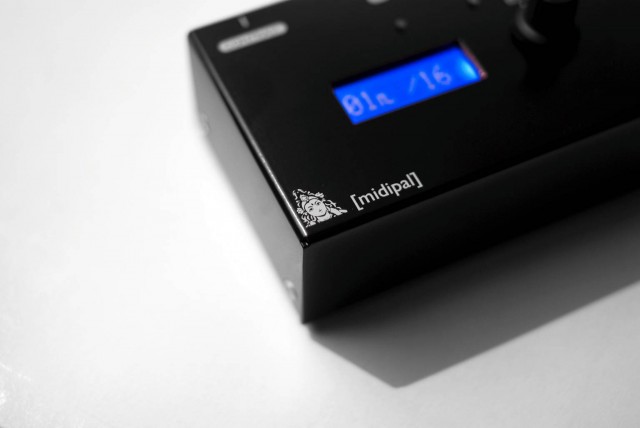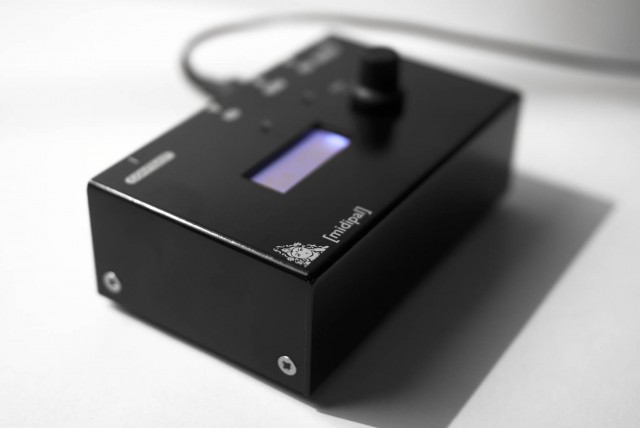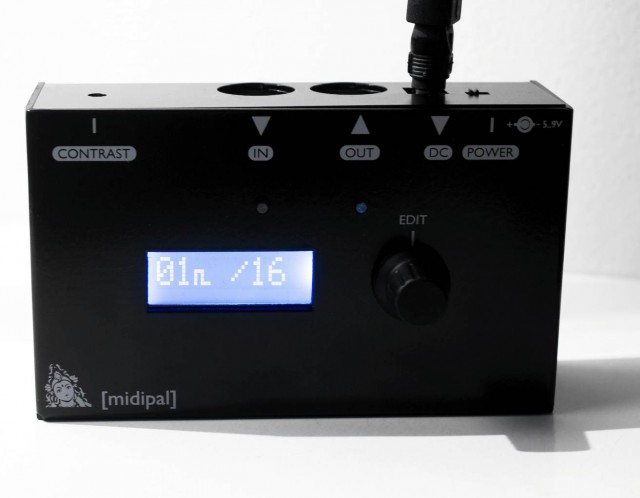Musically, compositionally, we think in notes and rhythms and patterns. MIDI may be a simple way of describing those elements, but it can be surprisingly expressive. And so, just as we have all sorts of boxes for adding effects to sound, there’s clear appeal to boxes that do stuff with musical patterns and information – a bit like a MIDI stompbox.
We saw one example last week in the form of the MCP. Here’s another appealing “magical MIDI box” – and it’s also open source hardware. Created by Olivier Gillet, maker of the open source Shruthi-1 synth, it’s an affordable and versatile musical companion to other music gear. (Comparing the MCP with MIDIpal: MCP is more expensive, but does add extra hands-on controls in the default case and a bigger LCD. The idea is similar, though for now MIDIpal also has more firmware options, and you can augment its controls by adding your own pots, sensors, and the like.)
The idea is this: plug a keyboard or sequencer or input on one end, and then something that makes sound on the other end. The MIDIpal sits between note input and sound output and … does stuff. What sort of stuff?
- Keyboard-controlled sequencer for drums.
- Note randomization.
- Chord memory.
- Arpeggiator.
- Delay.
- Constrain to a musical scale.
- Step sequencing.
- Clock, with groove/shuffle, and clock divider.
- LFO, using Control Change messages.
- Use sensors to generate MIDI messages.
- BPM counter.
- MIDI monitor display.
- Filter, split, merge, route.
You can also use it for other tasks, like playing a musical memory game or just generating MIDI messages for troubleshooting. You can even combine settings into one of four custom “multis” of four settings each.
Powered by 9V battery or power dongle. It’s open source hardware and you can modify the software code. 109 € for the full-assembled board in an aluminum case, 89 € in clear plexi, or 69 € for the assembled board alone.
I asked Olivier to tell us a little bit about how you’d use this, and how the design came about. He tells CDM:
Regarding use cases, it’s actually two beasts in one.
One side of the MIDIpal is that it tries to be a “Swiss Army knife” for MIDI. Working with MIDI equipment — especially old / esoteric / boutique pieces of kit — is sometimes confusing. Some modules have poor implementations and choke on some types of MIDI messages that really need to be stripped from the stream. Some controllers or modules lack proper MIDI channel number configuration. Some interesting controllers are hardwired to CC numbers that cannot be interpreted by our favorite module.
The MIDIpal provides some “plumbing” features for filtering events and channels. There are a few built-in modules for doing that (by lack of better terminology, they are called “apps”), but it can be programmed more in-depth with an editor. (midipal-editor.appspot.com – yes, it’s a web app and it generates a SysEx file with the filter. I’ve been fascinated by the idea of online customization of hardware since playing with Rainer Buchty’s Ensoniq tools !) It also offers two monitoring apps – one showing the messages, the other focused on the reliability of the clock to help troubleshooting a MIDI setup.
The other side is MIDI event processing for creative purposes. The MIDIpal UI is deliberately minimalistic (one encoder). It’s obviously not something you perform “on”; it’s more something you set up and perform “with,” from your keyboard. In a sense, the 49 or 61 keys of the keyboard are the real interface of the MIDIpal when used with those apps, including the classic arpeggiator and chord memory, a delay that can also transpose echoes and skew their velocity, and a scale processor which rounds all notes to a defined scale. The MIDIpal comes with two drum sequencers which are “played” from a keyboard. One of them is based on Euclidian patterns triggered through chords on the keyboard. (The octave defines the drum sound, the note defines the pattern length, the interval determines the density.) The other based on preset patterns that are “composed” when playing chords.
Used standalone (without MIDI keyboard), the MIDIpal can also generate a wide range of MIDI messages: a reference clock with shuffle, LFO-modulated CCs. It even has a 32-step sequencer with a CC value programmable for each step.
Some features are halfway between the utilitarian and the creative. One app called “dispatcher” can dispatch chords to different MIDI channels based on rules. It’s a simple way of building a polysynth out of a rack of monosynths, but by cycling or randomly routing each note to a different channel, it can also create rapid-fire timbre modulations reminiscent of wavetable sequencing. Composing one sequence and getting it to move rapidly between MIDI channels / programs is actually not that easy with standard sequencing software or hardware, but it’s such a nice effect! Ed.: Indeed; I loved the simple feature of creating arpeggiation between voices on the Korg Mono/Poly.
I have found that users are equally attracted by the “left brain” and “right brain” of the unit – usually for purposes they had not thought of at the time of purchase (just like a Swiss Army knife!) which could have been motivated by “I need an arp for my Euro setup.” It’s probably the simplest “box you can run your own MIDI processing code on” out there that’s self-contained. It can be battery powered and it does not need a computer to run – except for uploading/updating firmware of course. It could be a good opportunity for C/C++ programmers looking for an open hardware platform for processing MIDI. In February, someone on the Analog Heaven list mentioned the polyphonic sequencer of the JX3P, and I immediately implemented a custom MIDIpal firmware providing this feature. I really want to see new apps or features based on the MIDIpal, especially some tapping into the eigth spare analog inputs available on the PCB; that’s also why I sell the bare board at a reasonable price. I suspect it won’t be long before someone tries putting it in an Eurorack module with proper CV mixing and protection 🙂
One last bit: the whole “product design” discussion for this product, born as I needed a simple project to practice SMT soldering, is documented message-by-message on the Mutable Instruments forum. It makes for an interesting historical read, I particularly my initial “The thing should not take more than one day to design, and no more than one day to write the firmware for” 🙂
Thanks, Olivier. Check out the hardware at:
http://mutable-instruments.net/midipal/
And yes, Olivier is also cooking up a monster polyphonic synth, basically combining what he was doing in the Shruthi and … multiplying it. That’s coming this fall:
http://mutable-instruments.net/ambika
Previously:
MIDI Control Platform: One Open Box, Any Notes, Harmonies, and Rhythms [Gallery]


